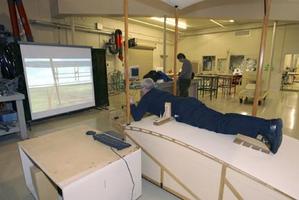I got back from Oshkosh Friday afternoon. It was a great trip. Monday evening I got an RV-6 flight with Mark Nielsen from Green Bay - I wanted to evaluate the Dynon EFIS that Mark had recently installed. I've got a few suggestions for improvements that I will send to Dynon, but I saw enough to confirm my decision to buy one and test it.
I'm not sure how many RVs were at OSH, but the large RV parking area was almost full. There were certainly enough RVs that I didn't take the time to study each one - I concentrated on the RV-8s and -8As. There were several exceptionally nice aircraft, and I learned a few things from inspecting them, and talking to the builders. I attended gatherings of RV-8/8A builders in the Theater in the Woods on Tuesday and Thursday - it was nice to be able to put a face on some of the people that I have been e-mailing. Every time I meet RV builders I am struck by what a great bunch of people they are. I don't know why, but there seem to be very, very few idiots, flaming A-holes, pompous jerks or other unpleasant types.
 Wright Flyer Simulator - As part of EAA's Countdown to Kittyhawk celebration of the 100th anniversary of the Wright Brothers' first flights, there were several Wright Flyer simulators at Oshkosh. They had a flat area to lay on, a hip cradle for lateral control and a lever for pitch control, just like the original Wright Flyer. The view ahead, including the biplane canard elevators, was projected on a large screen in front. It was quite difficult to fly, and many people crashed within 15 seconds of lift-off, but a small number of young kids did very well. Light weight helps I guess :)
Wright Flyer Simulator - As part of EAA's Countdown to Kittyhawk celebration of the 100th anniversary of the Wright Brothers' first flights, there were several Wright Flyer simulators at Oshkosh. They had a flat area to lay on, a hip cradle for lateral control and a lever for pitch control, just like the original Wright Flyer. The view ahead, including the biplane canard elevators, was projected on a large screen in front. It was quite difficult to fly, and many people crashed within 15 seconds of lift-off, but a small number of young kids did very well. Light weight helps I guess :)
The performance was quite poor (just like the real thing), and it was not possible to climb out of ground effect without stalling. The simulation appeared to be on some sort of military installation, with lots of buildings and trees. The optimum pitch attitude put the lower plane of the biplane canard on the horizon. So obstacle avoidance was a real problem. It was difficult to keep it flying in a straight line, and the screen had a field of view of about 10 degrees, so the unplanned turns would bring new obstacles into view.
Lateral control was a real issue - the aircraft was quite slow to respond to lateral control input (you slid sideways in the hip cradle to make a lateral control input).
I did two goes at the simulator. I got into a lateral pilot induced oscillation on the first one, and eventually hit a tree that came into view during a turn. The second attempt went much better, but it too eventually ended with a collision with a tree.